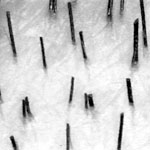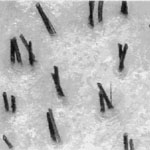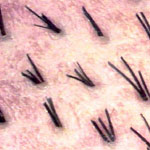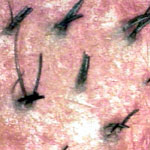Racial Variations
For Follicular Unit Transplants
For Follicular Unit Transplants
In the past, hair restoration surgeons approached the Asian patient with hair loss with considerable hesitation. This was because of the concern that it would be difficult to produce a natural looking transplant in a patient with dark, coarse hair and relatively light skin. This fear was justified by the limitations of older hair transplant techniques.
With the advent of Follicular Unit Transplantation all this has changed. The versatility of using follicular units enables the surgeon to successfully produce a completely natural looking transplant regardless of the person’s specific hair characteristics. Still, understanding the distinctive features of Asian hair is extremely important to achieve maximum cosmetic benefit from the transplant.
In general, Asian hair is characterized by being:
Coarse hair, makes large grafts look fuller and it is actually a benefit in Follicular Unit Transplantation. The reason is that hair shaft diameter is the major determinant of hair volume (in fact, hair shaft diameter is more important, at time, than the absolute number of hairs). Therefore, all things being equal, patients with coarse hair will have the greatest impact from the transplant per transplanted hair.
The concern that coarse hair may not look natural at the frontal hairline is not an issue since only individual, one-hair follicular units are used in this area and the finer hairs are used at the leading edge of the transplanted hairline. For the occasional patient with very coarse hair and light skin, the bottoms of the hair follicles can be ’intentionally damaged’ producing a finer textured hair that can add additional softness to the hairline, when appropriate.
Black hair on light skin tends to look less full than light hair on light skin because the increased contrast tends between the hair and skin color tends to exaggerate the spacing between the hair (like newspaper print). When hair and skin color match, the skin color acts as a “filler” between the hair shafts, softening the impact of less hair seen in patients with thinning hair. When there is significant contrast between hair and skin color (black hair on white or pale skin) and the hair shafts are fine, an additional transplant session may be needed to achieve the desired degree of fullness, and the patient should be made aware of this. In addition, side-to-side grooming patterns can greatly increase the appearance of fullness through the effects of layering. For the most part, the increased hair shaft diameter makes hair transplantation in Asians very successful, regardless of the color contrast of the hair and skin.
If we examine Asian hair with densitometry (30x magnification), we find that the Asian scalp contains follicular units of predominately 1-and 2-hairs, with 1-hair units being prevalent. This is in contrast to the typical Caucasian scalp that contains follicular units in groups of 2-, 3-, and even 4- hairs. See the following two Videoscans for comparison.
 Asian Scalp |

Caucasian Scalp |
In addition, the total number of hairs per area is less, so Asians average about 170 hairs per cm2, whereas Caucasians have around 210/cm2. The following table summarizes these differences:
| Caucasians | Asians | |
| Follicular Unit Density (mm2) | 2.0 | 1.6 |
| Predominant Hair Grouping | Two | 1.5 |
We can see from the above chart that although the hair density is each follicular unit is slightly lower in Asians, the number of follicular units are approximately the same, so comparable numbers of follicular unit grafts are available from the same sized donor strip. For the FUE procedure, the availability to two or more hair follicular units in Asians is not frequent. When the Asian hair is more coarse with a a greater hair shaft diameter, transplantation can be very successful in Asians.
A final aspect of Asian hair that has some bearing on the transplant is the angle that the hair emerges from the scalp. Whereas hair in most Caucasians tends to lie relatively flat (the angle that it emerges from the scalp is acute), Asian hair emerges less acute to the skin and thus appears to stand away from the scalp. Interestingly, hair in Asian newborns often stands “straight up.”
This has two interesting consequences. First, when Asian hair is long, the heavy weight of the thick shafts tends to bend it down, creating an illusion of fullness. (bent or “bowed” hair always looks more full than straight that sticks up like toothpicks. Grooming and styling techniques can capitalize on the layering potential of Asian hair. When Asian hair is very short, it tends to appear more “see-through” since the hair points straight out and the eye looks directly down the hair shafts, calling attention to the scalp.
The implication for surgery is that the doctor must replicate this angle exactly if the Asian patient is to get the most impact form his transplant and to keep the look of his original hair. This is a meticulous process when placing the hairs for a hair transplant. .
In sum, hair restoration surgery in Asians can be extremely gratifying, when the surgeon is aware of the unique aesthetic characteristics of Asian hair.
Patients of African descent are believed to be among the best candidates for hair restoration surgery, because of the low color contrast between their skin and hair, and the excellent coverage provided by its curl or kink of the hair. Unfortunately, the total hair count on an African scalp is the lowest hair count of the various races. This means that the availability of hair for hair transplants may be limited. Understanding the unique hair qualities of African hair enables the surgeon to help the African/African American patient achieve the best possible results.
The hair shaft of African hair is oval on cross section (in contrast the round shafts of Caucasians and Asians). This configuration allows the hair shaft to twist on itself and form the characteristic kinky or curly hair. This hair type provides excellent local coverage since each hair covers a large area around it. However, a limitation of this hair type is that the tight curl doesn’t allow the hair to be easily combed back to cover thin or bald areas that are some distance behind it so African men can’t take advantage of the layering so commonly used by Caucasians and Asians. To compensate for this, the surgeon should place at least a small amount of hair in all of the areas that need coverage.
The increased visual density of normal African hair provided by kinked nature of the hair may add bulk to to adjacent thin or bald areas when the hairs are transplanted. Although the increased visual density of kinky hair causes specific aesthetic problems when it is long, the low skin/hair color/contrast serves to greatly improve the cosmetic impact of balding when the hair is kept at a medium length..
African hair can be divided into two distinct, but overlapping types; one that is wiry and tightly kinked and other that has a looser, more wavy kink with a softer feel. The surgery in each case is different. The hair with the softer kink is usually fairly straight below the surface of the skin and can easily be removed from the donor area. The more tightly kinked hair curves significantly below the skin surface and at times, becomes a challenge for the surgeon. When strip surgery is performed, experienced surgeons learn to ‘carve’ out the hair from the strip; however when F”UE is performed, special tools are often used to minimize damage during the surgery. As a result of the unusual shape of these grafts, at the time of the surgery the recipient sites have to be slightly larger to accommodate the slightly larger kinked grafts.
The following video-scans illustrate two variations of hair growth patterns in Africans/African Americans.
 African patient with density of 1.6 hairs/mm2 and lightly kinky hair African patient with density of 1.6 hairs/mm2 and lightly kinky hair |
 African patient with density of 1.6 hairs/mm2 and very curly-kinky hair African patient with density of 1.6 hairs/mm2 and very curly-kinky hair |
African hair is also unique in that the density of naturally occurring follicular units is relatively low (they are spaced farther apart). During the transplant, the surgeon must account for this by spacing the grafts in African/African American patients slightly further apart to insure that there will be adequate coverage of the areas to be treated. Technically this works well, since the slightly larger grafts cannot be placed quite so close together and the hair itself, covers better when it grows out.
It is interesting to note that in spite of the relatively low density in African individuals, the scalps of individuals of African descent generally contain a significant proportion of 3-hair follicular units. It is possible that, in Africans, the low overall density with high follicular groupings and darkly pigmented hair and skin, enhances photoprotection while at the same time minimizing heating of the skin. Curly hair in tight groups of 3 may act like a scaffolding that holds the hair away from the surface of the scalp (to cool it), and in a tight meshwork (that blocks the sun), making both the hair and skin of the African well adapted for sunny, hot climates.
The following table compares some easily measurable aspects of the follicular units in Africans/African Americans and Caucasians.
| Caucasians | Africans | |
| Follicular Unit Density (mm2) | 2.0 | 1.6 |
| Predominant Hair Grouping | Two | Three |
The following chart summarizes the slightly different surgical techniques used in
Another important consideration when transplanting those of African descent is the characteristics of the donor scalp. Their scalps tend to be thicker, more fibrotic and less distensible. The thick scalp may give the impression that it is mobile and that donor closure for a strip surgery will be easy, but, in fact, the scalp tends to have little “give.” In order to insure a low-tension closure, the width of the donor incision should always be conservative.
A final issue in transplanting Africans/African Americans is their increased risk of hypertrophic scarring and keloids. Although the incidence of keloid formation is rare in the back of the scalp, the formation of hypertrophic scarring is quite common. This usually presents as a thin ridge along the suture line beginning several weeks after the surgery. It is readily amenable to intralesional corticosteroids, but it can lead to local hair loss along the line of the incision and, if not totally resolved, can make wearing a short hairstyle difficult.
A superficial, low-tension closure in a strip surgery uses only cutaneous sutures or staples that are removed early may decrease, but not eliminate the risk of this problem.
It is important to identify the common skin condition in Africans/African Americans called “Acne Keloidalis” which presents as small bumps on the back of the scalp. Although it is neither a “keloid” nor “acne,” the condition can cause local hair loss and may present a problem for the hair transplant surgeon if unrecognized.
In sum, hair restoration surgery in Africans/African Americans can be very rewarding for the patient, but the surgery must be performed with the physician carefully taking into account all of the unique characteristics of their hair and skin.
The hair and skin characteristics of Latinos are generally excellent for hair restoration. Thick, dark, wavy hair provides excellent coverage and the visual effect is enhanced by darker skin.
The average number of hairs/cm2 appears to be slightly lower in Latinos as compared to Caucasians, but the greater hair shaft diameter more than compensates, enabling the hair transplant surgeon to produce great results.